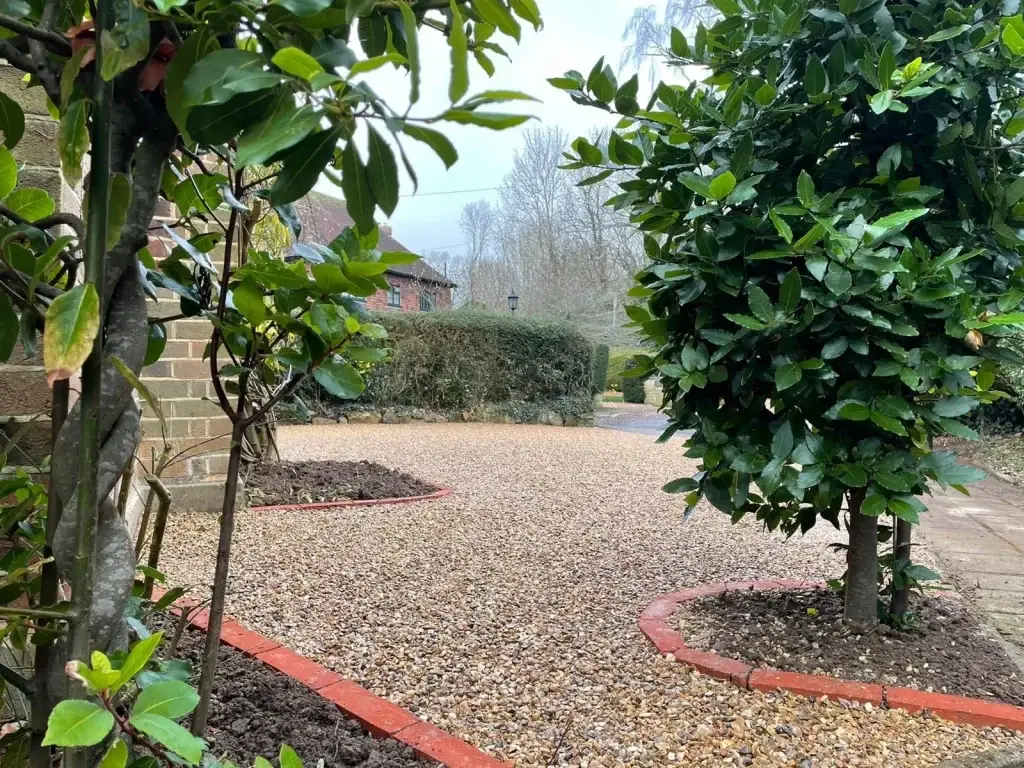A tar and chip driveway can be an affordable fix for your problem if your driveway is breaking and damaged or if you want to make a dirt or gravel driveway to something more durable.
What Is a Tar-and-Chip Driveway?
Driveways made of tar and chips are also occasionally referred to as chip seal, oil and stone, or macadam driveways. Nevertheless, whatever you choose to call them, they’re a lovely, cost-effective method to improve your driveway and provide your automobiles a smooth surface.
One of the most useful paving material options is tar and chip, commonly known as seal chip or chip-and-seal. You have probably driven over this surfacing material because it is used in driveways, parking lots, and roads, though it may not be as common as gravel or concrete.
Tar-and-chip pavement resembles asphalt in appearance but is installed differently. The surface is covered and crushed with successive layers of gravel, hot liquid bituminous asphalt, and additional loose stone.
Tar and chip driveways, which use a liquid type of asphalt and stone, are a less expensive alternative to an asphalt driveway. Driveways made of tar and chips have a natural stone appearance and are far more stable than gravel driveways.
Is a Tar-and-Chip Driveway Right for You?
If you’re looking for an informal and affordable paving material, tar-and-chip pavement can be your best option. Let us help you decide by providing you the reasons why you should choose Tar and Chip.
Design and Appearance
Tar-and-chip driveways have a distinctly rural appearance. They work well in rural areas or unstructured environments. Tar and chip can be a good paving material for areas with long driveways because they are cost effective.
Because the top layer of tar and chip driveways is made up of crushed stone, they initially resemble gravel walkways. It can be distinguished from asphalt most by its smooth black color, which contrasts with its tan, beige, gray, and slightly orange appearance.
Most likely, you have driven on one. One of the best cushioned traction for cars is provided by the bitumen layer beneath the crushed stone surface.
Traction
Tar and chip driveways are comparable to asphalt in terms of surface traction, except from their capacity to support larger loads. When you utilize tar and chip as the substance, you can anticipate an automobile gliding that is free of bumps.
Convenience and Comfort
The tar-and-chip paving’s roughness improves traction on slippery or snow-covered surfaces. Compared to tar and chip, asphalt and concrete are both more slick.
Maintenance and Repair
Tar-and-chip driveways require little maintenance. It doesn’t require as much sealing as asphalt, and little cracks usually mend on their own. Adding more hot bitumen and loose stone to the surface will renew it roughly every ten years.
Snowplows that push too hard risk scraping the tar-and-chip paving’s rough surface. A shovel or snow blower may be preferable to a plow if you can maintain the blade just above the surface.
Throughout the warm months, the thinner layers of chip would melt, and they would repair the cracks and fractures in the surface. But if you want to be certain, mending requires having to even out or add “tar” as needed and adding a fresh layer of chip.
Installation of Tar-and-chip
Most hard surfaces, such as tarmac, an ancient tar and chip driveway, concrete, etc., are laid with tar and chip if they are in good shape.
Tar and chip can be set on old tar and chip, but it cannot be laid on loose gravel. To prepare the surface, you must first sweep away any loose stones and dust.
A tar-and-chip driveway can be constructed very easily. A gravel base is first placed, as is typical for driveway materials. On top of the gravel is next poured a hot liquid asphalt. After that, loose stones are added and rolled into the bitumen to create the completed surface.
You can choose how your driveway will look once it is finished by picking the stones for the top layer. Stones come in a variety of colors from which you can pick to make a special and aesthetically pleasing surface.
As long as the driveway materials are in reasonable condition, tar-and-chip can be applied over them.
After installing your tar and chip drive, you should wait 48 hours before allowing foot traffic to allow the surface to dry. It’s best to wait a week before parking your car on your new driveway because the tar may only be fully cured after that time.
Since tar and chip driveways are less prevalent than asphalt or gravel driveways, it might be challenging to find qualified tar and chip driveway installers.
Before hiring a local tradesperson, conduct your research and check internet evaluations and testimonies. Companies that specialize in asphalt installation may not specialize in chip sealing.
Do I need drainage for a driveway made of tar and chips?
To be in compliance with UK requirements, your driveway must display proof of appropriate drainage. Tar and chip surfaces are not inherently permeable, therefore when creating a chip driveway, you should make arrangements for sufficient drainage.
If it’s not possible to direct the water to a stream or garden, you should hire a contractor to set up a basic drainage system.
What is the Best Weather to Install Tar-and-chip?
These driveways can only be installed in favorable weather conditions. Hot, dry weather is ideal. If the weather is cool, the asphalt cement may cool and set up to rapidly. The gravel may not achieve a high level of adhesion. Rain can wash away an emulsified asphalt before it cures.






